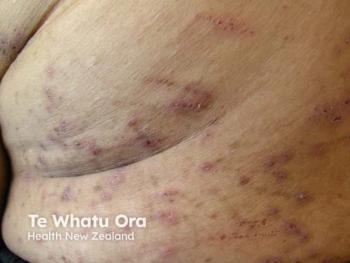
Study Highlights Efficacy of Lotion with Biotechnological Phytocomplex, Niacinamide, and Succinic Acid in Enhancing Microbiota Diversity and Reducing Acne Severity
The lotion effectively rebalanced the microbiota, reduced erythema and desquamation, and improved acne severity.
A novel lotion containing a biotechnological phytocomplex, niacinamide, and succinic acid improved the microbiota balance in patients with truncal acne, according to a
Furthermore, the lotion proved effective in reducing overall acne severity, erythema, desquamation, and improving the inhibition of biofilm formation and other virulence factors.
Background and Methods
Authors of the present study referenced a recent study that investigated the effects of M. citrifolia callus lysate on dysbiosis-related processes. The findings demonstrated that this lysate reduced the growth and biofilm formation of various microbes. Additionally, it alleviated acne symptoms and successfully restored microbial skin homeostasis.2
Using this and other factors as a baseline, researchers Guerra-Tapia et al conducted an open-label, prospective study assessing the effects of a topical lotion on mild to moderate truncal acne. The study, conducted from October 2022 to February 2023, spanned 8 weeks (56 days) with evaluations conducted at baseline, 7 days, 14 days, 28 days, and 56 days. Researchers conducted a skin microbiota analysis by extracting samples from acne-affected areas at the start and end of the study.
Participants in the study were Caucasian individuals between the ages of 12 and 35 years who had presented with oily skin and 2 or more months of persistent acne. Individuals were excluded from participation if they actively utilized anti-acne or hormonal treatments, had underwent recent treatments or surgeries in the affected area, or had a history of autoimmune conditions or past allergic reactions to cosmetic products.
Participants applied Vincobiosis acneic lotion, which included Canonia allysis, niacinamide, and succinic acid, on a twice-daily basis following the application of a neutral cleansing gel.
Findings
Out of 43 initial participants, 42 patients were evaluated after 1 dropout unrelated to the study, with researchers conducting a comprehensive microbiota analysis with 84 samples collected before and after the treatment. The majority of patients had presented with back acne (88.37%).
An analysis of the alpha diversity of the skin microbiota showed a significant increase after 56 days of treatment. However, the evenness of microbial distribution did not change significantly. Beta diversity increased significantly post-treatment, suggesting that treatment led to more variability in microbial communities across participants.
As a result of treatment with the lotion, researchers observed a significant decrease in Actinobacteriota and an increase in Bacteroidota. No changes were noted in Firmicutes or Proteobacteria.
The dominant genera were Cutibacterium (C. acnes), Staphylococcus, and Streptococcus. Notably, Cutibacterium decreased significantly from 67.05% to 58.57%, while Staphylococcus and Streptococcus levels remained stable.
C. acnes showed a significant decrease from 66.43% to 58.11%, while S. epidermidis remained unchanged.
Acne severity, as measured by the Investigator's Global Assessment (IGA) scale, improved significantly, with an 18.99% reduction detected after 28 days, and a 27.59% reduction observed after 56 days. A substantial proportion of patients (60.47%) exhibited improvement by at least 1 point on the IGA scale after 56 days.
Furthermore, there was a non-significant decrease in open and closed comedones, with significant reductions observed in inflammatory lesions such as papules (49.66%) and pustules (ranging from 57.14% to 62.19%), with no marked changes observed in nodules or cysts.
The lotion also significantly reduced both the count (up to 22.38%) and size (up to 30.83%) of porphyrins, indicators of C. acnes activity. Erythema also decreased significantly, with a 17.29% improvement after 7 days and an 18.33% improvement in 56 days. The desquamation index, indicative of skin renewal, decreased by 63.83%.
Conclusions
"The novel mechanism of action of the biotechnological phytocomplex consisting of C. sinensis and M. citrifolia callus lysates, niacinamide, and succinic acid, contained in the lotion, was beneficial for the treatment of mild to moderate truncal acne based on its ability to rebalance the skin microbiota and inhibit virulence factors such as biofilms, reducing the severity of acne and the number of inflammatory lesions," according to Guerra-Tapia et al.
Researchers did not outline any specific limitations associated with the study or its design.
Moving forward, they suggested further exploration of the potential of quorum sensing inhibition in skin microbiota rebalancing.
References
- Guerra-Tapia A, Martínez H, Nieto C, et al. A new topical biotechnological phytocomplex for truncal mild-moderate acne restores skin microbiota balance. Skin Res Technol. July 23, 2024.
https://doi.org/10.1111/srt.13806 - Cañellas-Santos M, Rosell-Vives E, Montell L, Fernandez-Campos F. Anti-inflammatory and anti-quorum sensing effect of a novel biotech ingredient for treatment of acne. EADV Symposium. 2023, P013.
Newsletter
Like what you’re reading? Subscribe to Dermatology Times for weekly updates on therapies, innovations, and real-world practice tips.


















